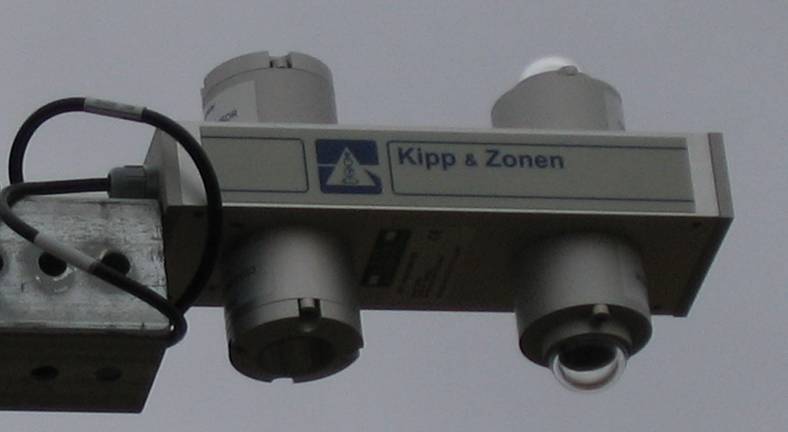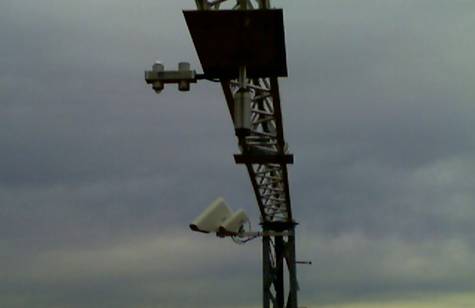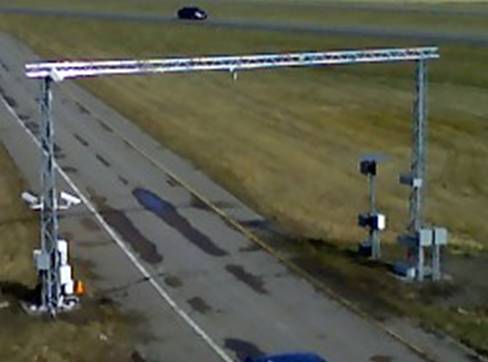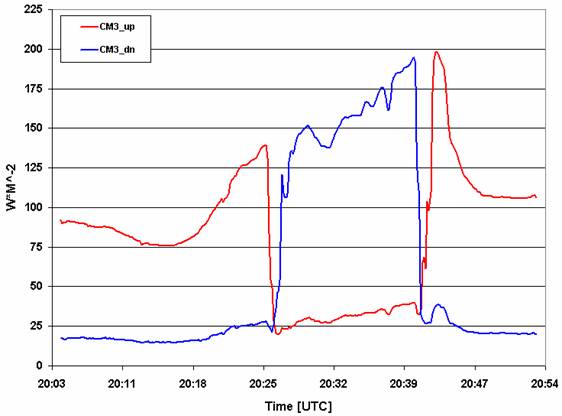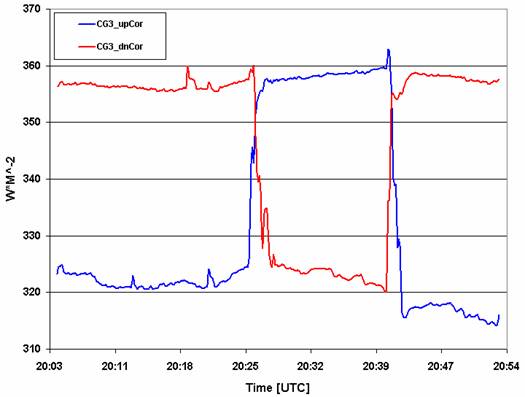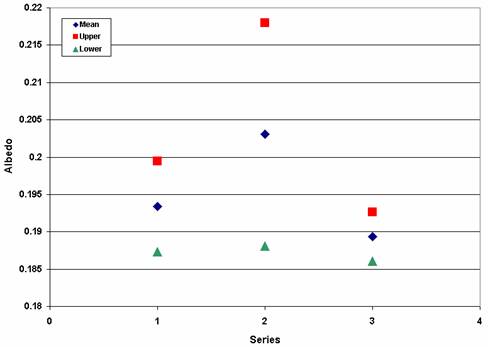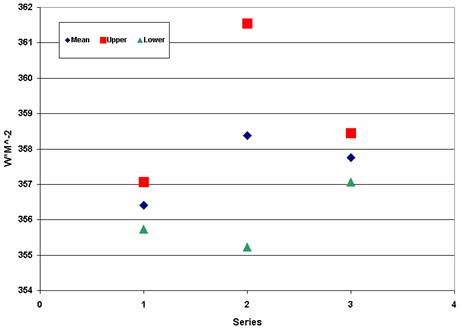Table of Contents
Kipp & Zonen CNR1 Net Radiometer
Description
Cost
- Purchase: ~$5000.00
- Maintenance: negligible
- Calibration: $85.00/hour for repair
Purchase cost as quoted from November 2006 Campbell Scientific U.S. Price list. Cost does not include any mounting structure considerations, either available through Campbell Scientific or created by the user.
Maintenance costs considered negligible outside of any cost of manual labor of mounting and keeping the instrument clean once assembled. Only maintenance associated with instrument is globe and silicon window cleaning and any calibration checks, neither of which require special cost considerations.
The instrument comes calibrated from Campbell Scientific. Should the sensor fail repeated calibration checks the instrument would be sent back to Campbell Scientific for repairs, where the rate of repair costs would dictate the extent of the cost.
Measurement Physics
The measurement of net radiation must consider upward and downward components of shortwave (solar) and longwave (terrestrial) radiation, satisfying the net radiation equation:
Net = Incoming shortwave - Outgoing shortwave + Incoming longwave - Outgoing longwave
Incoming solar radiation is made up of two components, direct and diffuse beam shortwave radiation. Direct beam solar radiation is energy received by the surface directly from sunlight. Direct beam is a function of any absorption or screening by atmospheric constituents. Diffuse beam solar radiation is energy received by the surface from the scattering of light by atmospheric constituents. Diffuse beam radiation is the “brightness” observed on an overcast day in the absence of direct beam sunlight and is a product of the same properties that cause the sky to be blue and clouds to appear white. Incident diffuse solar radiation is subject to the same atmospheric absorption that direct beam radiation is attenuated by.
Outgoing, or reflected, shortwave radiation is a function of the surface albedo. Albedo is the ratio of outgoing shortwave radiation to incoming shortwave radiation, where bright surface (such as snow) have a high albedo and dark, black surfaces (such as asphalt) have a low albedo (~0.1).
Incoming and outgoing longwave radiation is a function of the temperature of a surface to the fourth power. According to the Stefan-Boltzmann law for radiating blackbodies:
Radiation emitted = Stefan Boltzmann Constant * Object Temperature ^ 4
Gray bodies, surfaces that are not perfect emitters of absorbed radiation, emit as a function of that surface's emissivity, such that:
Radiation emitted = emissivity * Stefan Boltzmann constant * Temp ^ 4
Incident longwave radiation is a function of atmospheric absorption and atmospheric composition. Clear sky atmospheres radiate less than clouded atmospheres since cloud droplets have a larger mass that absorb the emitted earth's radiation and emit that radiation back to the surface.
Measurement characteristics for each component of net radiation must isolate the intended effects of one component while ensuring that other effects are not being observed. The Kipp & Zonen CNR1 Net Radiometer's method of measurement is through a thermal detector that responds to the heat gain or loss due to absorption or emission of radiation.
The Kipp & Zonen CNR1 Net Radiometer is made up of an upward and downward facing pyranometer and pyrgeometer which measure solar and longwave radiation, respectively. Each sensor features a thermopile that converts the heating or cooling difference into a voltage which is converted to a watts per meter-squared measurement.
The pyranometer measures shortwave radiation by featuring a flat black surface that is heated by the amount of light it observes. The pyranometer measures both direct beam and diffuse solar radiation as long as the sensor has a constant, unobstructed view of sunlight. The pyranometer ensures that it does not observe longwave radiation by the presence of two glass domes over the black surface. The glass domes are opaque to longwave radiation and transparent to shortwave radiation, ensuring that the surface is only heated by light sources. The first dome protects from atmospheric or surface longwave heating effects, and the second dome protects from any longwave energy emitted by the first glass dome itself. The glass surface itself also deflects some light radiation as the use of glass employs an acting spectral range of light received by the sensor of 305 to 2800 nanometers.
The pyrgeometer measuring longwave radiation employs a similar theory as the pyranometer, only the sensor is transparent to longwave radiation and opaque to any light sources. This is obtained by the presence of a black silicon layer on top of the pyrgeometer heating surface, which is sensitive to any atmospheric or surface longwave heating, and meanwhile deflecting all solar radiation from the heating surface. The black, silicon surface features a spectral range of 3 to 50 micrometers.
Performance Characteristics
CNR1 Specifications
- Sensor sensitivities: All four sensors have equal sensitivity
- Pt-100 sensor temperature measurement: DIN Class A
- Expected accuracy of the temperature measurement: +/- 2 K
- Operating Temperature: -40 to +70 degrees Celsius
- Requirements for data acquisition:
- Radiation components: 4 differential or 4 single-ended analog channels
- Pt-100 temperature: 1 excitation and 2 differential analog channels
- Expected accuracy for daily totals: +/- 10%
- Cable length: 15 m (each, for two cables)
- Weight: 4 kg
CM3 Specifications
- Response time 95%: 18s
- Non-stability: < 1% change per year
- Non-linearity: Max. dev. 2.5% (0 - 1000 W/m^2)
- Directional error: Max. 25 W/m^2 at 1000 W/m^2
- Spectral selectivity: Max. dev. 5% (350 - 1500 nm)
- Temperature dependence of sensitivity: 6% (-10 to +40%)
- Tilt response: Max. dev. 2%
- Overall ISO classification: second class
- Sensitivity: 10 - 35 microVolts/(W/m^2)
- Impedance: 125 Ohm nominal
- Operating temperature: -40 to +80 deg. Celsius
- Spectral range: 305-2800 nm
- Expected signal range for atmospheric application: 0 - 15 mV typical
- Expected accuracy for daily sums: +/- 10%
CG3 Specifications
- Response time 95%: 18s
- Non-stability: < 1% change per year
- Non-linearity: Max. dev. 2.5% (0-1000 W/m^2)
- Temperature dependence of sensitivity: 6% (-10 to +40 degrees Celsius)
- Tilt response: Max. 3% when facing downwards
- Field of view: 150 degrees
- Sensitivity: 5 - 35 microVolts/(W/m^2)
- Impedance: 125 Ohm nominal
- Operating temperature: -40 to +80 degrees Celsius
- Temperature range for specified behavior: -10 to +40 degrees Celsius
- Measurement range: -250 to 250 W/m^2 (uncorrected)
- Spectral range: 5 to 50 micrometers
- Expected signal range for atmospheric application: -4 to 4 mV
- Expected accuracy for daily sums: +/- 10%
- Window heating offset: Max. 25 W/m^2 at 1000 W/m^2 normal incidence solar radiation
Performance characteristics relevant to the operation of the CNR1 net radiometer include the +/- 10 W/m^2 resolution of a second class pyranometer as well as limitations of measurement due to cosine and azimuth error for any pyranometer. Cosine error stems from heating irregularities on the heating surface (due to the thermopile) when the sun is heating the pyranometer from a low angle. Azimuth error stems from errors in measurement when the sun is not at a high enough sun angle.
Albedo varies over the course of the diurnal solar cycle due to changing sun angle and reflectivity characteristics of the surface. Likewise, a pyranometer has albedo measurement limitations, observed in unrealistic values in early sunrise and late sunset samples. Sensor noise may also lead to unrealistic values of shortwave radiation during night, as radiational cooling of the instrument may actually produce a negative value, though the magnitude of this value is within natural sensor variation.
Field Projects
Two CNR1 Net Radiometers are currently employed at the University of North Dakota Surface Transportation Weather Reserach Center Road Weather Field Research Facility, characterizing pavement radiation loading and validation of numerical weather prediction radiation forecasts.
A CNR1 is mounted on a truss over the road surface to characterize albedo and emission characteristics of the pavement.
Live data from all instrumentation at the Road Weather Field Research Facility is available at
Documentation
Campbell Scientific Kipp & Zonen CNR1 Net Radiometer Manual
http://www.campbellsci.com/documents/manuals/cnr1.pdf
Pyranometer classification documentation
http://www.eol.ucar.edu/rtf/facilities/isff/sensors/kippzonen/brochure_cm21.pdf
Pavement Radiation Loading Through Pavement Temperature
Reference
Meteorological Measurement Systems Fred V. Brock and Scott J. Richardson Copyright 2001 Oxford University Press, Inc.
Solar and Terrestrial Radiation Kinsell L. Coulson Copyright 1975 Academic Press, Inc.
An Introduction to Atmospheric Radiation, Second Edition K. N. Liou Copyright 2002, Elsevier Science (USA)
Introduction to Micrometeorology S. Pal Arya Copyright 2001 Academic Press
Calibration
Method
Calibration is performed by Campbell Scientific and Kipp & Zonen that establishes a calibration constant for each pyranometer and pyrgeometer, converting the voltage to a defined measurement value.
True calibrations generally must be sent back to the manufacturer to test and reassess the calibration constant. Possible adjustment of calibration constant for pyranometer could be performed with the use of a secondary standard (research grade) pyranometer to test any possible biases in performance not attributed to sensor noise. Calibration constant adjustments for pyrgeometers could be obtained by using a known surface temperature measurement for a surface which is contained in the complete field of view of the pyrgeometer component.
The calibration constants determined by the manufacturer are considered valid for 2 years. Calibration checks can be performed through defined resolution and certainties of higher grade instruments, or an “instrument flip” of the net radiometer under stable radiative conditions which was performed with one of the CNR1 at the Road Weather Field Research Facility.
The “instrument flip” calibration check as defined by Campbell Scientific rotates the net radiometer 180 degrees such that the labeled upward facing sensors actually face down, and likewise the labeled downward facing sensors are facing upward. An assumption of stable radiative conditions is required for the experiment, as the threshold for an acceptable calibration check is 10%, thus radiative conditions varying more than that will lead to inconclusive results. Because the pyranometer measures both direct and diffuse beam radiation, the check can be performed in either the clear or overcast stable radiative conditions.
This experiment design deployed a CNR1 on a portable apparatus where the road surface was completely within the field of view of the downward facing sensors. Measurements of the incident conditions were taken before and following the sensor flips to test the stability of the radiative environment. The CM3 test is illustrated in figure 1 and the CG3 test is illustrated in figure 2.
Figure 1. CM3 pyranometer flip test. Solar radiation is provided in W/m^2 on the y-axis, with the programmed upward facing sensor (red) and the programmed downward facing sensor (blue) plotted against time. The flip was performed at approximately 20:25 UTC and the sensor was rotated back upright at approximately 20:40 UTC
Figure 2. CG3 pyrgeometer flip test. Longwave radiation in W/m^2 on the y-axis, with the programmed upward facing sensor (red) and the programmed downward facing sensor (blue) plotted against time.
Figure 1 illustrates how the incident shortwave environment was not constant over the course of the experiment. Due to the extremely overcast conditions, the magnitude of radiation doubled over the course of the experiment. Figure 2 illustrates how the incident longwave environment was generally stable, as overcast conditions were consistent enough to promote generally constant incident longwave values. While albedo is also dependent on incident longwave radiation, it is expected to vary significantly over changing sun angle and substantial magnitudes of difference in solar radiation. Although the magnitude of radiation doubled, it is due to how small the incident shortwave radiation is thus an albedo analysis is expected to minimize the effect of the solar evolution in the experiment, and is presented in figure 3. Due to the constant nature of the longwave experiment, variability in surface emitted longwave radiation is considered acceptable for the terms of the experiment, and is presented in figure 4.
Figure 3. Albedo variability. Mean value, upper certainty bound, and lower certainty bound of albedo measurement (y-axis) plotted against series number (x-axis). Series 1 and 3 were when the instrument was normally oriented and series 2 was when the radiometer was flipped. Certainties were established from standard deviation in albedoes throughout each series.
Figure 4. Surface emitted longwave variability. Mean value, upper certainty bound, and lower certainty bound of surface emitted longwave measurement (y-axis) plotted against series number (x-axis). Series 1 and 3 were when the instrument was normally oriented and series 2 was when the radiometer was flipped. Certainties were established from standard deviation in surface emitted longwave radiation throughout each series.
Albedo values are output directly from the net radiometer, but had to be calculated for series 2 due to the sensor being flipped. The higher variability of series 2 in each experiment is likely due to there being no instrument level on the flip side of the instrument, and thus introducing more uncertainty. Future experiments could use an external level sitting on the instrument to determine if the sensor is level.
Each series tested within the defined certainties observed in each experiment. The manufacturer manual suggests that variations within 10% are acceptable during this experiment, of which both the albedo and surface emitted longwave radiation tests passed.
Sources of Error
Sources of error for normal operation, assuming proper calibration and setup:
- Heating and cooling due to wind (glass globes)
- Azimuth and cosine errors
- Accuracy dependent on sensor being level
- Globes and silicon windows dirt-free and debris-free
- Spectral range limitations of pyranometer
- Albedo errors due to sensor noise or low sun angles
Exposure Requirements
The instrument must be oriented towards the south such that no shadows from the instrument or mount are underneath the sensor. The instrument must be placed in a location where there will be no shading effects obstructing the direct beam of the sun over the course of the entire year (or field project). Furthermore, all sensors should be free of any objects in the plane of view that could contribute reflections into the upward or downward facing sensors.
Kipp & Zonen maintain that for proper net radiation measurements, the sensor must be mounted at a height of at least 1.5 meters above the surface. When the instrument is mounted H meters above the surface, 99% of the input of the lower sensors comes from a circular area with a radius of 10*H. Any shadows or surface disturbances with radius < 0.1*H will affect the measurement by less than 1%. Kipp & Zonen maintains to minimize mounting considerations, the CNR1 should be mounted to a separate vertical pipe that is at least 25 feet from any other mounting structures. Additionally, if wishing to characterize the albedo and longwave emission characteristics of a constant surface, the downward facing sensor must be observing a constant surface within its plane of view.
A number of limitations are introduced to the exposure requirements of the CNR1 Net Radiometers mounted at the Road Weather Field Research Facility. The analysis of pavement radiation loading wishes to characterize the radiative characteristics of a pavement surface, though to maintain operation of the field site the radiometer must be mounted at a high enough height to allow traffic on the road surface below. Additional mounting limitations stem from the inability to mount the sensor 25 feet away from any mounting structures. To assess these inconsistencies applied to the downward facing sensors, the albedo of the road is characterized by determining the true albedo characteristics of the road with the second net radiometer at a height where the entire road surface is within the field of view of the downward facing sensors. By using these albedo characteristics, the net radiation is then calculated by using the determined albedo and the observed incident radiation. Surface emitted longwave radiation is calculated by using pavement temperature sensors and the Stefan Boltzmann equation to calculate the emitted radiation of the road.
Deployment
Measurement Methods
The CM3 pyranometer and CG3 pyrgeometer sensors of the CNR1 Net Radiometer each obtain measurement through voltage generation from differential heating of a thermopile. The Pt-100 temperature sensor within the CNR1 is a thermocouple which obtains its measurement through generated voltages from differential heating. Calibration constants convert generated voltages to measures of W/m^2 for radiation measurements, or degrees Celsius or Kelvin for temperature measurement. The sensor must be mounted and secured as level in an environment for the net radiation measurement to be considered within the range of accuracy suggested by Kipp & Zonen.
Deployment Platforms
The CNR1 Net Radiometer can be deployed in any environment where point measurements of the net radiation flux are desired. Platform considerations should take both intended surface characteristics to be observed as well as any obstructions of direct beam solar radiation that could influence net incoming radiation. If attempting to characterize the albedo and longwave emission characteristics over an entire surface area, the radiometer should be mounted at ample height to include the area of study. If attempting to characterize the radiative characteristics of an individual surface, siting should ensure that the downward facing sensors are seeing only that surface. CNR1 measurements are still valid in shaded environments, they are however only representative of the net radiation flux at that unique location and cannot generally be assumed to represent a larger area. The CNR1 can be used to characterize the radiative environment for any given surface, surface conditions, and sky conditions. The CNR1 can be further used to characterize the evolutions all these factors as well.
Deployment is made possible through the connection of the CNR1 to a pipe that extends from a mounting tower. Mounting structures are available from Campbell Scientific as well as can be created and assembled using traditional hardware by the user. Deployment methods should attempt to minimize any mounting structure interference in the downward facing sensors. Deployment should avoid the placing of the radiometer in any locations where reflections may contaminate the sensor measurement.
Communication
A data logger is required to accept the voltages output by the net radiometer, with voltage and data logger programming requirements established by Campbell Scientific. The CNR1 outputs four voltages that typically range from 0 to 15 mV for the CM3 sensors, and +/- 5mV for the CG3 sensors. Differential voltage measurements are recommended for better noise reduction, but not required. Data logger programs employ the calibration coefficients and convert the provided voltages into measures of W/m^2 for radiation, degrees Celsius and Kelvin for sensor temperature, and ratios for albedo. Data logger programs also perform the operations of calculating net radiation, net solar radiation, net longwave radiation, combined incident radiation, and combined surface reflected and emitted radiation.
Power and Installation
The CNR1 is powered through the connectivity to the data logger, which is connected to either a battery or other charging source. Of the two main cables stemming out of the CNR1, one wire within one of the cables is connected in a corresponding location on a data logger. The measurements are obtained from the completion of the circuit by the connection of all other wires.
Installation is completed by connecting each wire from the CNR1 to a data logger, that reads each voltage generated at each location where a cable is plugged in and converts it to the corresponding measurement, based on the program that is uploaded to the data logger.
Data
Quality Control
Quality control of instrument data is performed by post-processing unrealistic values from the compiled output files and replacing them with missing value codes. Unrealistic values can be produced during normal operation due to sensor noise in certain radiative environments. During nighttime hours in the absence of solar radiation, noise in pyranometer output varies over approximately +/- 3 W/m^2. As stated in the sources of error, the negative values are a result of sensible or latent heating or cooling on the instrument. Albedo values during the nighttime should be completely replaced with missing value codes, due to negative values, values greater than one, and undefined values of albedo all being observed due to the noise of each sensor. Furthermore, any negative values of solar radiation should be replaced with missing value codes as those values are physically unrealizable.
Albedo data generally cannot be directly input into models or processing routines due to the variation in albedo with sun angle. In sufficient sun angle environments the albedo still varies as a function of location in the sky and characteristics of surface dependence on albedo. In insufficient sun angles (less than 25 degrees), albedo may meet quality assurance standards but are not truly realizable. With an instrument mounted at 20 feet high, and due to the plane of view of a pyranometer, albedo values may be very close to one thanks to some direct beam contamination in the lower sensor.
Quality Assurance
Quality assurance is performed for net solar radiation measurements during daylight hours by ensuring all albedo measurements are less than one. Quality assurance for net longwave measurements is generally performed by ensuring that incident longwave generally does not exceed surface emitted longwave radiation. Exceptions exist for this longwave assurance, and considerations to surface composition (snow) and cloud conditions may be required if data fails this assurance yet is still realistic.
